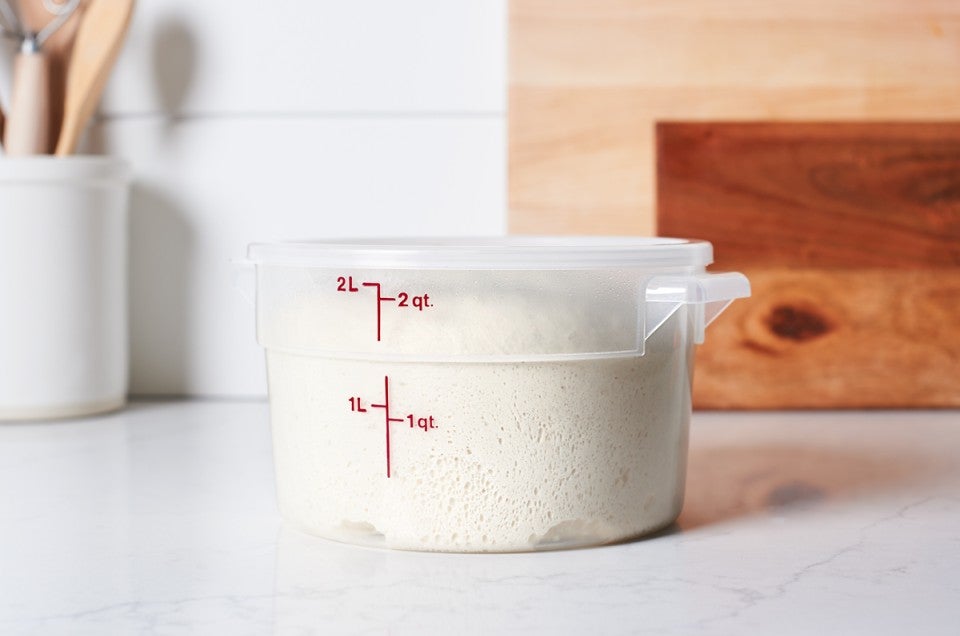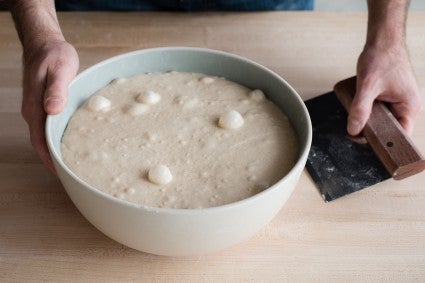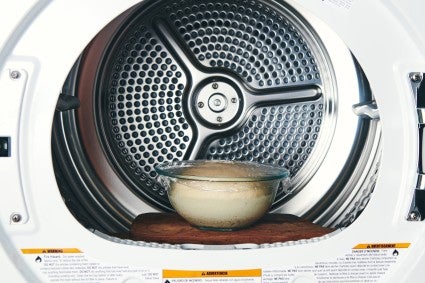Things bakers know: Proof your bread dough in this unexpected spot
The best place to proof dough is ... your laundry room?


Last winter, I was testing bread recipes — lots and lots of bread recipes — while working on the manuscript for King Arthur’s forthcoming bread cookbook (coming fall 2024!). While my colleagues in the Test Kitchen were producing lofty loaves of Seeded Sourdough and Japanese Milk Bread, my sluggish doughs took hours to rise in my home kitchen and my breads baked up squat.
I asked my colleague: How warm is it in the Test Kitchen, where eight ovens are almost always on? A balmy 75°F. By contrast, my kitchen was a put-on-another-sweater 63°F. It was obvious why my loaves weren’t turning out well: My kitchen was too cold for the dough to thrive.

Temperature is one of the most critical elements of the bread-making process, because it has such a direct impact on fermentation. Not only do we want our dough to be at the optimal temperature (75°F to 78°F) after it’s mixed, but we also want to maintain that temperature throughout the process, from mixing through bulk fermentation and right up until the loaf goes into the oven. It’s what makes the difference between a great loaf and a so-so one. And it’s an element that can be manipulated by the baker, by adjusting the temperature of the water you use for the mix (warmer in cold months, cooler in warm), and/or by warming up (or cooling down) the environment in which your dough is fermenting.
I don’t own a bread proofer (yet), though it’s an investment I’ll probably make soon if I plan to make bread as often as I have this last year. And I don’t have the paper-thin Raisenne Dough Proofer either, though a strong case can be made for this super thin mat, what we call “an electric blanket for bread.” But I do have a dryer.

Yes, reader, that’s right: I’ve been bulk fermenting my doughs in my dryer. And guess what? It works great. After looking around my house for a “warm, draft-free spot,” as so many recipes recommend, I found the ultimate cozy nest for my rising dough. First, I “preheat” the dryer for about 10 minutes. In reality, what I typically try to do is time my dough to a load of laundry (it’s called multitasking!) so I’m not heating the dryer exclusively for my dough; I’m just taking advantage of its residual heat. When the dryer is warm, I open the door and plunk my bowl of covered dough right inside, nesting it in some warm, dry clothes (note that clothing is optional; you can remove it before you add your dough), and shut the dryer door, trapping the heat within.
That cozy bread cave stays warm for quite a while, and inside my doughs rise beautifully — and much more quickly than in my cold kitchen. It’s warm in there, but not too warm; I don’t have to worry about the dough fermenting too quickly.
Of course, I’m not the first to repurpose a household appliance for better bread. I know people swear by proofing their doughs in the dishwasher (another draft-free spot) or the microwave (with a cup of boiling water alongside). And while I was sheepish to admit this hack to my colleague and bread expert Martin Philip, even he gave it the green light: “Whether in the dryer, the microwave, the dishwasher, or on your counter, the ambient conditions of the dough during fermentation will make or break your final loaf. I’m not opposed to the dryer! Whatever it takes to guide fermentation.”
If you live somewhere cool — or simply struggle with sluggish dough — give the dryer trick a spin!
Wondering if your bread is ready to bake? Check out this blog, How to tell if bread dough has risen enough.


January 17, 2024 at 12:18pm
In reply to I use my slow cooker. Turn… by Lisa (not verified)
Using a slow cooker is genius, Lisa!
January 10, 2024 at 1:00pm
When I was a young and very poor college student, I would proof my bread in my car and punch it down between classes!
January 9, 2024 at 7:36pm
It’s often chilly here in San Francisco, and I often place an insulated bowl of dough over a heating pad (low)—especially for sourdough.
January 15, 2024 at 2:03am
In reply to It’s often chilly here in… by Jim (not verified)
I've been doing that for years, sourdough or not. Has always done a great job in my cold rural kitchen.
January 9, 2024 at 4:34pm
I use my oven with the light on to proof. I turn the light on about a 1/2 before I’m ready to start.
January 8, 2024 at 2:15pm
I also use my electric oven, but find no need to prewarm it. It has two 40w incandescent bulbs, which offer all the heat needed. With the oven door closed and the oven lights on, the temperature gets to the mid 80s, and with the door ajar, it's around 78, perfect for fermenting dough. I also slap a post-it note on the control panel so that no one (including me) will be tempted to preheat the oven for another project before my dough has had its rise.
January 8, 2024 at 12:24pm
What about in the oven with just the light on? Is that too warm? (I'm specifically wondering about proofing sourdough bread for the overnight bulk ferments...)
January 13, 2024 at 11:23am
In reply to What about in the oven with… by Lindsey R (not verified)
Hi Lindsey, as you can see from the comments here, many folks do rely on their oven with the light on for dough-rising purposes. However, over time the heat in the oven can creep up to 100°F or higher, so it's helpful to have a thermometer in there as well. This is because for most breads an ideal dough temperature is between 75-78°F, and 100°F is definitely too warm. I would also be very reluctant to use this method when proofing bread for an overnight bulk ferment, since in most cases an overnight ferment would require a much cooler environment (70-72°F).
January 14, 2024 at 5:32pm
In reply to What about in the oven with… by Lindsey R (not verified)
That’s too warm at least in my oven.
January 8, 2024 at 10:53am
Noting that this would never work at my home. My dryer is vented through an unheated lean to, directly to the outside. The interior of my dryer is typically about 60ºF in the winter. Since I'm not using my oven all of the time (being a home cook and not a test kitchen) I often use my oven for rising. And I'm lucky enough to have two ovens, so even if one is in use, the other is available.
Pagination